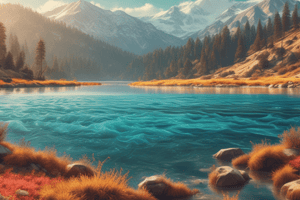Podcast
Questions and Answers
What does biological potential refer to?
What does biological potential refer to?
Which type of survivorship curve is characterized by high survivorship in the young and low survivorship in older age?
Which type of survivorship curve is characterized by high survivorship in the young and low survivorship in older age?
What does a population experience when the reproduction rate equals 1?
What does a population experience when the reproduction rate equals 1?
What is the primary difference between potential range and actual range?
What is the primary difference between potential range and actual range?
Signup and view all the answers
In what type of dispersion pattern are individuals spread out evenly across a space?
In what type of dispersion pattern are individuals spread out evenly across a space?
Signup and view all the answers
Which process primarily leads to rainfall at the equator?
Which process primarily leads to rainfall at the equator?
Signup and view all the answers
What environmental condition is typically found on the upward side of a mountain?
What environmental condition is typically found on the upward side of a mountain?
Signup and view all the answers
What drives the movement of ocean water?
What drives the movement of ocean water?
Signup and view all the answers
Which zone of the ocean allows for photosynthesis due to sunlight penetration?
Which zone of the ocean allows for photosynthesis due to sunlight penetration?
Signup and view all the answers
What biome is characterized by low shrubbery and is often subject to fires?
What biome is characterized by low shrubbery and is often subject to fires?
Signup and view all the answers
In which hemisphere does the south-facing side of a mountain receive more sunlight?
In which hemisphere does the south-facing side of a mountain receive more sunlight?
Signup and view all the answers
What are abiotic factors in determining where a species lives?
What are abiotic factors in determining where a species lives?
Signup and view all the answers
What aspect does demography analyze in relation to populations?
What aspect does demography analyze in relation to populations?
Signup and view all the answers
What happens to air as it rises at the equator?
What happens to air as it rises at the equator?
Signup and view all the answers
What causes the intensity of sunlight to be lower at higher latitudes?
What causes the intensity of sunlight to be lower at higher latitudes?
Signup and view all the answers
Which term describes the localized climate conditions in a small area that differ from the surrounding climate?
Which term describes the localized climate conditions in a small area that differ from the surrounding climate?
Signup and view all the answers
What is proximate causation primarily concerned with?
What is proximate causation primarily concerned with?
Signup and view all the answers
How does elevation affect temperature in mountainous regions?
How does elevation affect temperature in mountainous regions?
Signup and view all the answers
What is the ultimate causation related to an organism's trait or behavior?
What is the ultimate causation related to an organism's trait or behavior?
Signup and view all the answers
Which of the following statements regarding climate and weather is true?
Which of the following statements regarding climate and weather is true?
Signup and view all the answers
What occurs when warm air containing moisture cools down?
What occurs when warm air containing moisture cools down?
Signup and view all the answers
Study Notes
Climate Factors
- Ocean temperature impacts climate patterns.
- Elevation affects temperature; higher altitude leads to cooler and thinner atmosphere, increasing UV radiation exposure.
Microclimates
- Defined as localized climate conditions differing from their general surroundings.
- Example: Lichens thrive in specific microhabitants due to unique microclimatic conditions.
Understanding the Supernatural
- Supernatural phenomena cannot be observed or measured using scientific methods.
- Scientific approach involves:
- Observation
- General ideas (theory/law)
- Predictions/hypotheses
- Specific observations/experiments
Fundamental Principles
- Environments are diverse and heterogeneous.
- Resources are often finite and unevenly distributed.
- Organisms interact diversely with their environment and each other.
- Distribution of organisms varies across regions.
- Contingency refers to conditions relying on specific factors.
- All organisms have a lifespan (mortality).
Causation in Ecology
- Causation chains represent sequences of ecological events culminating in outcomes.
- Proximate causation identifies immediate causes, while ultimate causation explores evolutionary reasons behind traits.
Climate vs. Weather
- Weather encompasses short-term conditions like temperature and humidity.
- Climate refers to long-term trends and average conditions.
Sunlight Intensity and Earth's Tilt
- Sunlight is less intense at higher latitudes due to oblique angles; more intense near the equator.
- Earth's axial tilt causes variance in solar energy distribution.
Atmospheric Circulation
- Warm air rises at the equator due to intense heating, leading to precipitation.
- Air descends and cools at 30°N and 30°S, creating dry conditions; example includes the Sahara Desert.
- Convection cells driven by solar radiation influence weather patterns.
Ocean Dynamics
- Ocean currents are affected by Earth's rotation and wind patterns.
- Gyres circulate heat in oceans through warm and cold currents.
Topographical Effects on Climate
- Mountain slopes can create distinct microclimates; windward sides are typically moist while leeward sides are dry.
- North-facing sides (in the Northern Hemisphere) receive more sunlight leading to varied vegetation.
Biomes Overview
- Major biomes include tropical forests, savannas, grasslands, chaparral, tundra, and boreal forests.
- Aquatic zones classified into intertidal, continental, photic (photosynthesis possible), and aphotic (no light).
Species Distribution Factors
- Abiotic factors: temperature, humidity, non-living environmental conditions.
- Biotic factors: interactions with other species, food availability, predators.
- Species mobility influenced by ancestral regions.
Demography
- Population studies analyze changes over time, focusing on birth/death rates and immigration/emigration trends.
- Density indicates crowding in a specific area.
Survivorship Curves
- Type I: High survival in youth; low in old age.
- Type II: Uniform survival across all ages.
- Type III: Low survival early, high in later stages.
Reproductive Strategies
- Fecundity measures offspring quantity under ideal conditions; varies by species (e.g., fish).
- Biological potential reflects maximum reproductive capacity of a species.
- Potential range includes all habitats that could support a species; actual range is the current living area.
Population Dispersion Patterns
- Uniform dispersion: individuals evenly spaced.
- Clumped dispersion: individuals grouped in patterns.
- Random dispersion: individuals spread without a specific arrangement.
Population Growth Dynamics
- Population size indicators: if growth ratio equals one, the population remains stable; less than one indicates decline, more than one indicates growth.
- Exponential growth: population size increases without resource limits.
- Logistic growth: initial rapid growth slows down as it nears environmental carrying capacity, influenced by resource limitations.
Studying That Suits You
Use AI to generate personalized quizzes and flashcards to suit your learning preferences.
Description
Explore the intricate relationship between ocean temperature, elevation, and climate in this quiz. Understand how altitude affects temperature, oxygen levels, and UV radiation exposure. Delve into the concept of microclimates and their unique weather conditions.




